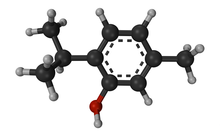Thymol

| |

| |
| Names | |
|---|---|
| Preferred IUPAC name
5-Methyl-2-(propan-2-yl)phenol[1] | |
| Systematic IUPAC name
5-Methyl-2-(propan-2-yl)benzenol | |
| Other names
2-Isopropyl-5-methylphenol, isopropyl-m-cresol, 1-methyl-3-hydroxy-4-isopropylbenzene, 3-methyl-6-isopropylphenol, 5-methyl-2-(1-methylethyl)phenol, 5-methyl-2-isopropyl-1-phenol, 5-methyl-2-isopropylphenol, 6-isopropyl-3-methylphenol, 6-isopropyl-m-cresol, Apiguard, NSC 11215, NSC 47821, NSC 49142, thyme camphor, m-thymol, and p-cymen-3-ol
| |
| Identifiers | |
3D model (
JSmol ) |
|
| ChEBI | |
| ChEMBL | |
| ChemSpider | |
| DrugBank | |
ECHA InfoCard
|
100.001.768 |
| EC Number |
|
IUPHAR/BPS |
|
| KEGG | |
PubChem CID
|
|
| UNII | |
CompTox Dashboard (EPA)
|
|
| |
| |
| Properties | |
| C10H14O | |
| Molar mass | 150.221 g·mol−1 |
| Density | 0.96 g/cm3 |
| Melting point | 49 to 51 °C (120 to 124 °F; 322 to 324 K) |
| Boiling point | 232 °C (450 °F; 505 K) |
| 0.9 g/L (20 °C)[2] | |
Refractive index (nD)
|
1.5208[3] |
| Pharmacology | |
QP53AX22 (WHO )
| |
| Hazards | |
| GHS labelling: | |
  
| |
| Warning | |
| H302, H314, H411 | |
| P260, P264, P270, P273, P280, P301+P312, P301+P330+P331, P303+P361+P353, P304+P340, P305+P351+P338, P310, P321, P330, P363, P391, P405, P501 | |
Except where otherwise noted, data are given for materials in their standard state (at 25 °C [77 °F], 100 kPa).
| |
Thymol (also known as 2-isopropyl-5-methylphenol, IPMP), C10H14O, is a natural
Chemical synthesis
Thymol is produced by the
- CH3C6H4OH + CH2CHCH3 → ((CH3)2CH)CH3C6H3OH
History
The bee balms
Thymol was first isolated by German chemist Caspar Neumann in 1719.[14] In 1853, French chemist Alexandre Lallemand[15] (1816-1886) named thymol and determined its empirical formula.[16] Thymol was first synthesized by Swedish chemist Oskar Widman[17] (1852-1930) in 1882.[18]
Extraction
The conventional method of
Uses

Thymol during the 1910s was the treatment of choice for
List of plants that contain thymol
- Illicium verum
- Euphrasia rostkoviana[28]
- Lagoecia cuminoides[29]
- Monarda didyma[30]
- Monarda fistulosa[31]
- Mosla chinensis
- Ocimum gratissimum L.[32]
- Origanum compactum[33]
- Origanum dictamnus[34]
- Origanum onites[35][36]
- Satureja thymbra
- Thymus glandulosus[33]
- Thymus hyemalis[39]
- Thymus serpyllum
- Thymus praecox
- Thymus vulgaris[39][40]
- Thymus zygis[41]
- Trachyspermum ammi
Toxicology and environmental impacts
In 2009, the U.S. Environmental Protection Agency (EPA) reviewed the research literature on the toxicology and environmental impact of thymol and concluded that "thymol has minimal potential toxicity and poses minimal risk".[42]
Environmental breakdown and use as a pesticide
Studies have shown that hydrocarbon
Compendial status
See also
- Thymoquinone
- Nigella sativa
- Bromothymol
Notes and references
- ISBN 978-0-85404-182-4.
- ^ "Thymol". PubChem. Retrieved 1 April 2016.
- ^ Mndzhoyan, A. L. (1940). "Thymol from Thymus kotschyanus". Sbornik Trudov Armyanskogo Filial. Akad. Nauk. 1940: 25–28.
- OCLC 959875923.
- ^ CAS Registry: Data obtained from SciFinder[full citation needed]
- .
- ISBN 9780323150422.
- ISBN 3527306730.
- ^ "A Brief History of Thyme - Hungry History". HISTORY.com. Archived from the original on 13 June 2016. Retrieved 9 June 2016.
- ^ Grieve, Mrs. Maud. "Thyme. A Modern Herbal". botanical.com (Hypertext version of the 1931 ed.). Archived from the original on 23 February 2011. Retrieved 9 February 2008.
- ^ Huxley, A., ed. (1992). New RHS Dictionary of Gardening. Macmillan.
- ^ "Thyme (thymus)". englishplants.co.uk. The English Cottage Garden Nursery. Archived from the original on 27 September 2006.
- ISBN 978-0-87842-359-0.
- doi:10.1098/rstl.1724.0061. On page 324, Neumann mentions that in 1719 he distilled some essential oils from various herbs. On page 326, he mentions that during these experiments, he obtained a crystalline substance from thyme oil, which he called "Camphora Thymi" (camphorof thyme). (Neumann gave the name "camphor" not only to the specific substance that today is called camphor but to any crystalline substance that precipitated from a volatile, fragrant oil from some plant.)
- ^ Marie-Étienne-Alexandre Lallemand (December 25, 1816 - March 16, 1886)
- ^ Lallemand, A. (1853). "Sur la composition de l'huile essentielle de thym" [On the composition of the essential oil of thyme]. Comptes Rendus (in French). 37: 498–500.
- ^ Karl Oskar Widman (aka Carl Oskar Widman) (January 2, 1852 - August 26, 1930)
- .
- PMID 15330107.
- ^ Ferrell, John Atkinson (1914). The Rural School and Hookworm Disease. US Bureau of Education Bulletin. Vol. 20, Whole No. 593. Washington, DC: U.S. Government Printing Office.
- ^ Milton, Joseph Rosenau (1913). Preventive Medicine and Hygiene. D. Appleton. p. 119.
- ^ Inskeep, Steve; Godoy, Maria (11 June 2013). "Za'atar: A Spice Mix With Biblical Roots And Brain Food Reputation". NPR. Retrieved 24 February 2022.
- PMID 15943766.
- ^ Ward, Mark (8 March 2006). "Almond farmers seek healthy bees". BBC News. BBC.
- ^ PMID 18381775.
- ^ "Thymol" (PDF). US Environmental Protection Agency. September 1993.
- ^ "Menthol | Definition, Structure, & Uses | Britannica". www.britannica.com. 6 October 2023. Retrieved 30 October 2023.
- PMID 26000025.
- .
- PMID 28157176.
- S2CID 24267822.
- ISSN 1878-5352.
- ^ PMID 14522450.
- .
- PMID 20355032.
- S2CID 81307357.
- S2CID 94582250.
- .
- ^ .
- .
- .
- ^ 74 FR 12613
- S2CID 89798604.
- ^ The British Pharmacopoeia Secretariat (2009). "Index, BP 2009" (PDF). Archived from the original (PDF) on 11 April 2009. Retrieved 5 July 2009.
- ^ "Japanese Pharmacopoeia" (PDF). Archived from the original (PDF) on 22 July 2011. Retrieved 21 April 2010.
External links
![]() Media related to Thymol at Wikimedia Commons
Media related to Thymol at Wikimedia Commons
